

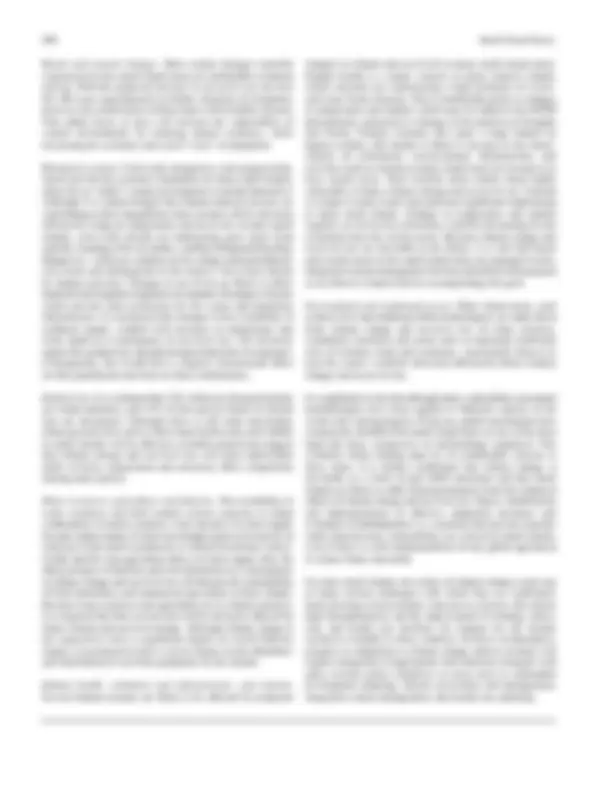
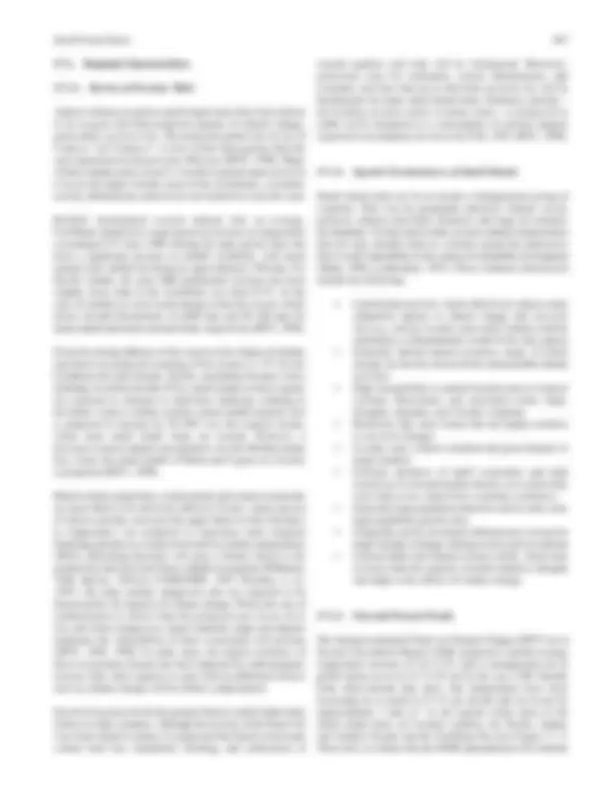
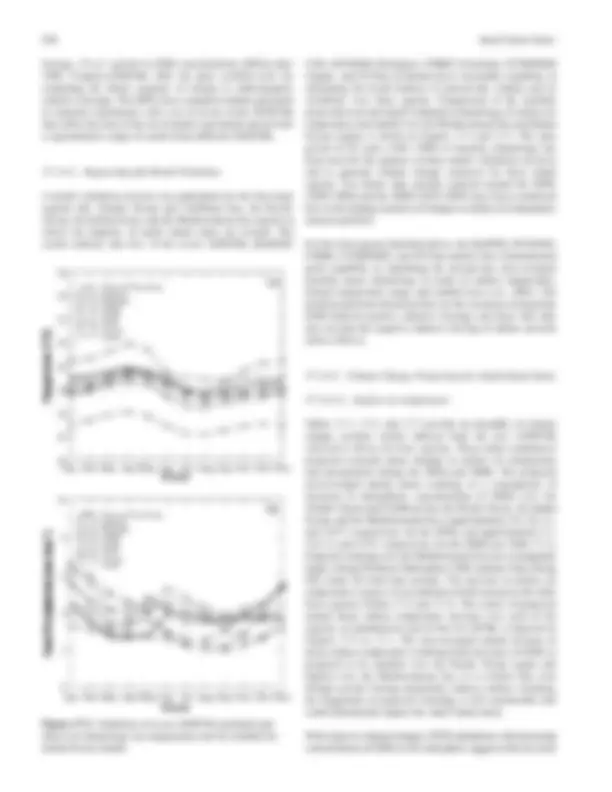
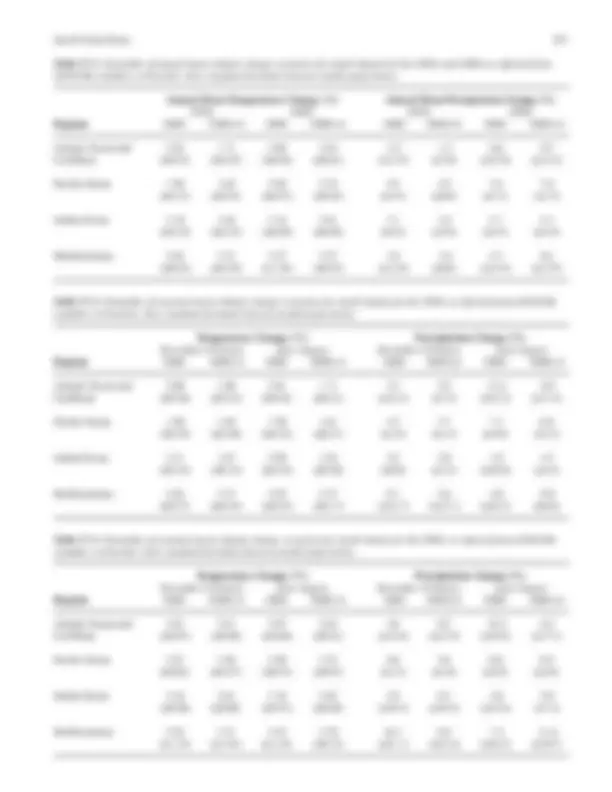
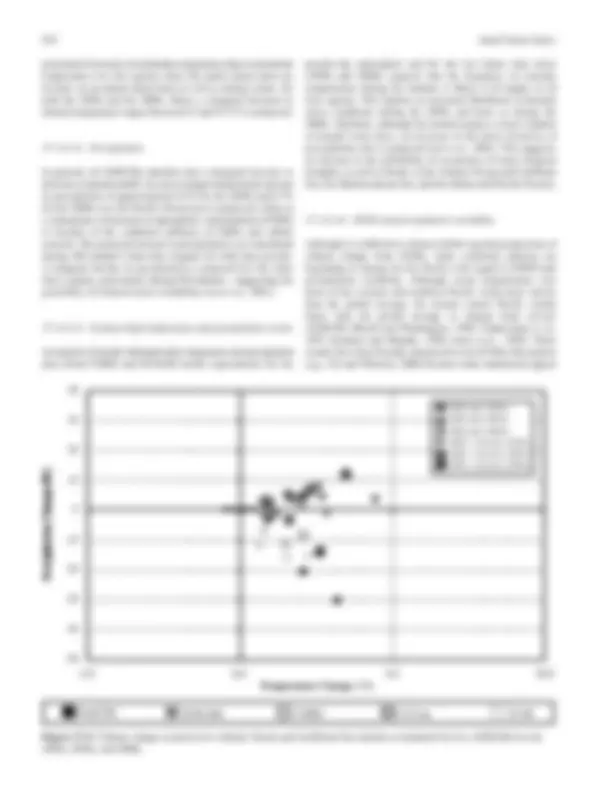

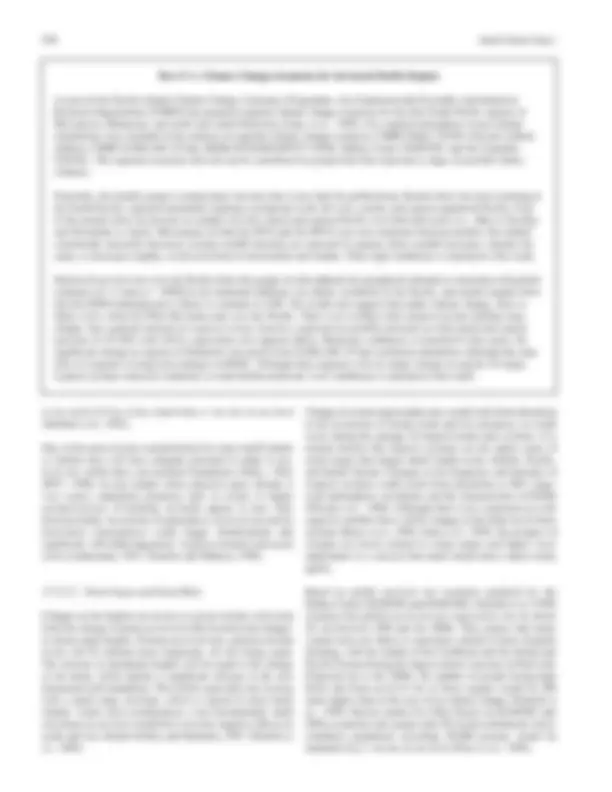

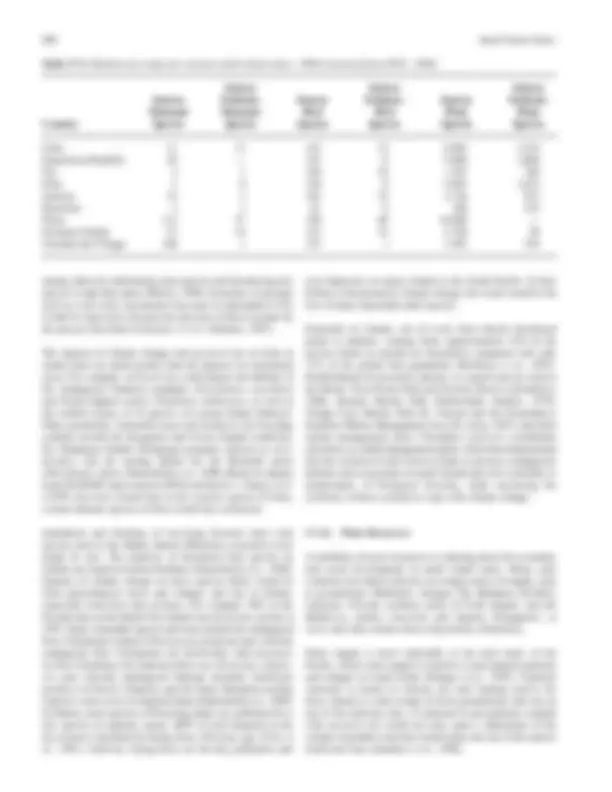



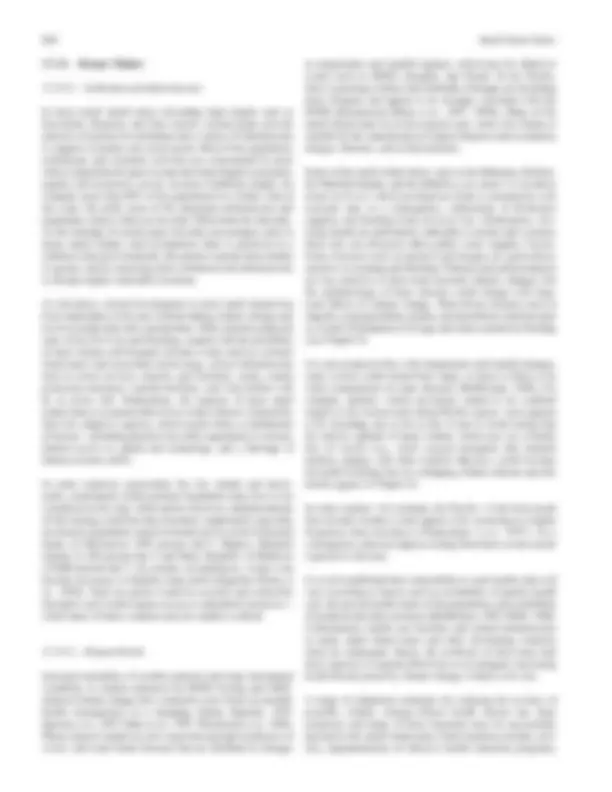
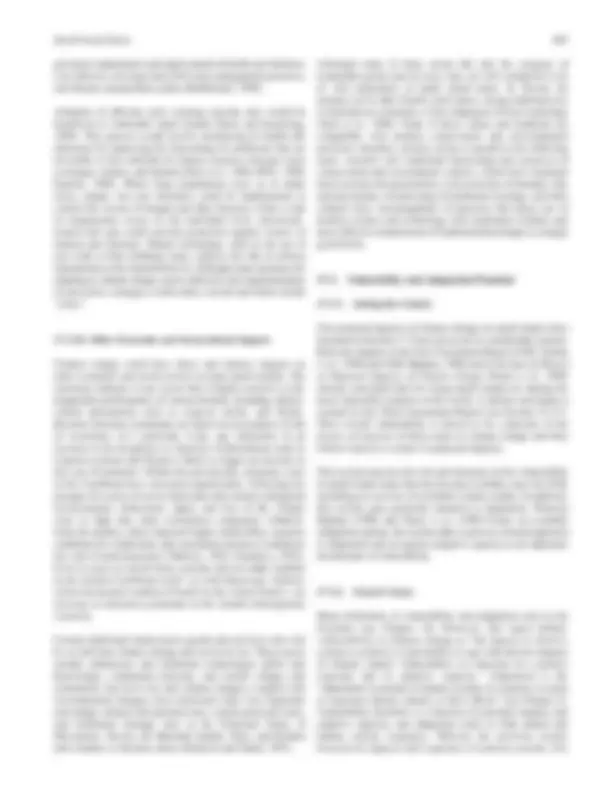
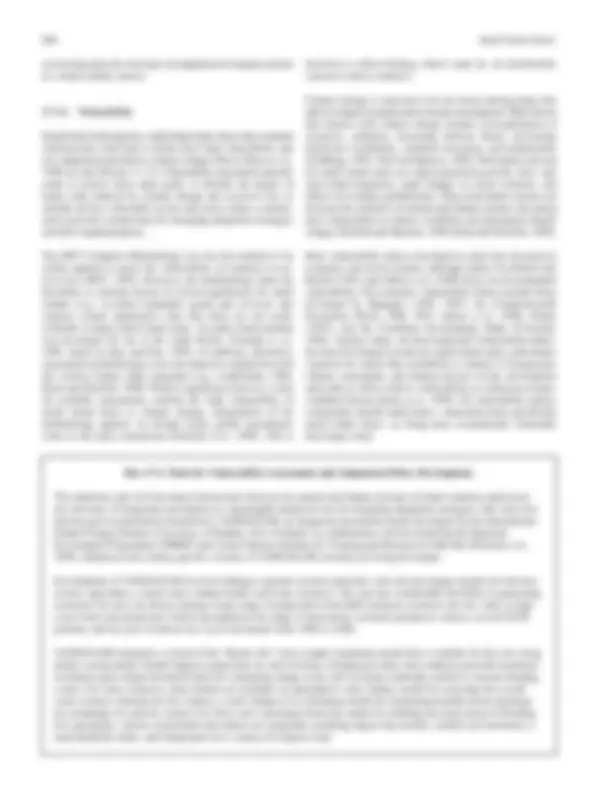
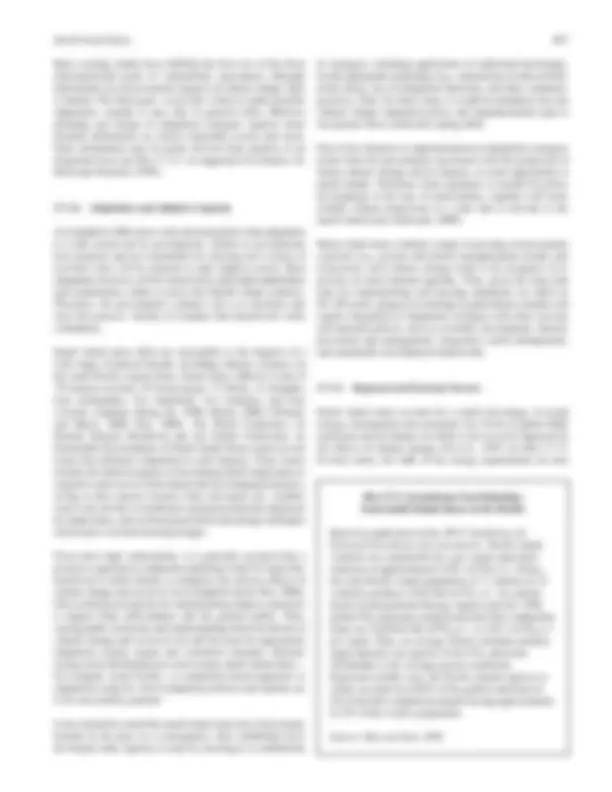
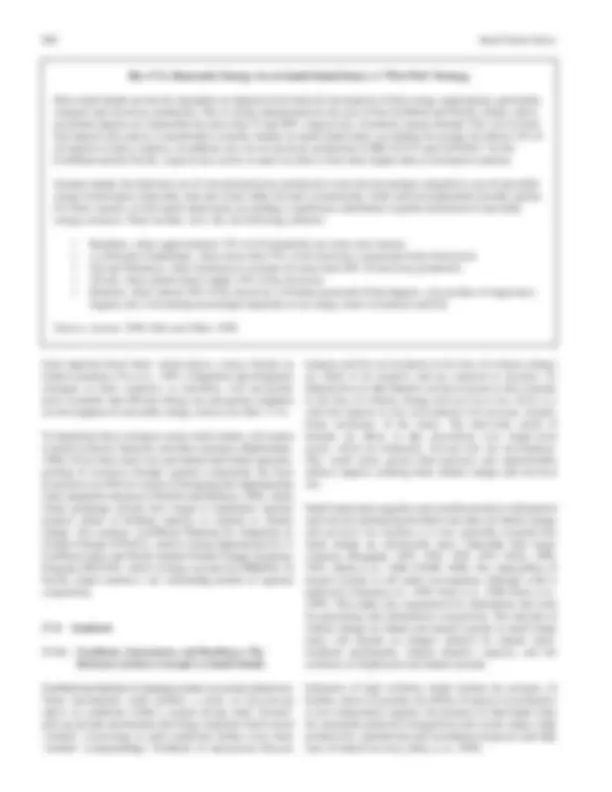










Study with the several resources on Docsity

Earn points by helping other students or get them with a premium plan


Prepare for your exams
Study with the several resources on Docsity

Earn points to download
Earn points by helping other students or get them with a premium plan
Community
Ask the community for help and clear up your study doubts
Discover the best universities in your country according to Docsity users
Free resources
Download our free guides on studying techniques, anxiety management strategies, and thesis advice from Docsity tutors
The vulnerability of small island states to climate change, highlighting their common features such as limited physical size, natural resources, and infrastructure, as well as their high susceptibility to natural hazards and extreme openness to external market shocks. The document also explores the consequences of climate change for small island states, focusing on changes in sea levels, rainfall regimes, and prevailing winds, and the impact on human settlements, water supply, fisheries, and human health. The document emphasizes the need for adaptation measures and the development of vulnerability indices to support adaptation planning and implementation.
What you will learn
Typology: Study notes
1 / 34

This page cannot be seen from the preview
Don't miss anything!



























17.4.1. Feedbacks, Interactions, and Resilience:
Beach and coastal changes. Most coastal changes currently experienced in the small island states are attributable to human activity. With the projected increase in sea level over the next 50–100 years superimposed on further shoreline development, however, the coastal assets of these states will be further stressed. This added stress, in turn, will increase the vulnerability of coastal environments by reducing natural resilience, while increasing the economic and social “costs” of adaptation.
Biological systems. Coral reefs, mangroves, and seagrass beds, which provide the economic foundation for many small islands, often rely on “stable” coastal environments to sustain themselves. Although it is acknowledged that human-induced stresses are contributing to their degradation, these systems will be adversely affected by rising air temperature and sea levels. In most small islands, coral reefs already are undergoing great stress from episodic warming of the sea surface, causing widespread bleaching. Mangroves—which are common on low-energy, nutrient/sediment- rich coasts and embayments in the tropics—have been altered by human activities. Changes in sea levels are likely to affect landward and longshore migration of remnants of mangrove forests, which provide some protection for the coasts and backshore infrastructure. It is projected that changes in the availability of sediment supply, coupled with increases in temperature and water depth as a consequence of sea-level rise, will adversely impact the productivity and physiological functions of seagrasses. Consequently, this would have a negative downstream effect on fish populations that feed on these communities.
Biodiversity. It is estimated that 33% of known threatened plants are island endemics, and 23% of bird species found on islands also are threatened. Although there is still some uncertainty about precisely how and to what extent biodiversity and wildlife in small islands will be affected, available projections suggest that climate change and sea-level rise will cause unfavorable shifts in biotic composition and adversely affect competition among some species.
Water resources, agriculture, and fisheries. The availability of water resources and food remain critical concerns in island communities. In many countries, water already is in short supply because islands (many of which are drought-prone) rely heavily on rainwater from small catchments or limited freshwater lenses. Arable land for crop agriculture often is in short supply; thus, the likely prospect of land loss and soil salinization as a consequence of climate change and sea-level rise will threaten the sustainability of both subsistence and commercial agriculture in these islands. Because water resources and agriculture are so climate sensitive, it is expected that these sectors also will be adversely affected by future climate and sea-level change. Although climate change is not expected to have a significant impact on world fisheries output, it is projected to have a severe impact on the abundance and distribution of reef fish population on the islands.
Human health, settlement and infrastructure, and tourism. Several human systems are likely to be affected by projected
changes in climate and sea levels in many small island states. Human health is a major concern in many tropical islands, which currently are experiencing a high incidence of vector- and water-borne diseases. This is attributable partly to changes in temperature and rainfall, which may be linked to the ENSO phenomenon, and partly to changes in the patterns of droughts and floods. Climate extremes also place a huge burden on human welfare; this burden is likely to increase in the future. Almost all settlements, socioeconomic infrastructure, and activities such as tourism in many island states are located at or near coastal areas. Their location alone renders them highly vulnerable to future climate change and sea-level rise. Tourism is a major revenue earner and generates significant employment in many small islands. Changes in temperature and rainfall regimes, as well as loss of beaches, could be devastating for the economies that rely on this sector. Because climate change and sea-level rise are inevitable in the future, it is vital that beach and coastal assets in the small island states are managed wisely. Integrated coastal management has been identified and proposed as an effective framework for accomplishing this goal.
Sociocultural and traditional assets. Other island assets, such as know-how and traditional skills (technologies), are under threat from climate change and sea-level rise. In some societies, community structures and assets such as important traditional sites of worship, ritual, and ceremony—particularly those at or near the coasts—could be adversely affected by future climate change and sea-level rise.
It is significant to note that although many vulnerability assessment methodologies have been applied to different regions of the world with varying degrees of success, global assessments have consistently identified the small island states as one of the most high-risk areas, irrespective of methodology employed. This evidently robust finding must be of considerable concern to these states. It is further established that climate change is inevitable as a result of past GHG emissions and that small islands are likely to suffer disproportionately from the enhanced effects of climate change and sea-level rise. Hence, identification and implementation of effective adaptation measures and avoidance of maladaptation ( i.e., measures that increase exposure rather than decrease vulnerability) are critical for small islands, even if there is swift implementation of any global agreement to reduce future emissions.
For most small islands, the reality of climate change is just one of many serious challenges with which they are confronted. Such pressing socioeconomic concerns as poverty alleviation; high unemployment; and the improvement of housing, educa- tion, and health care facilities all compete for the slender resources available to these countries. In these circumstances, progress in adaptation to climate change almost certainly will require integration of appropriate risk reduction strategies with other sectoral policy initiatives in areas such as sustainable development planning, disaster prevention and management, integrated coastal management, and health care planning.
17.1. Regional Characteristics
17.1.1. Review of Previous Work
Almost without exception, small island states have been shown to be at great risk from projected impacts of climate change, particularly sea-level rise. The projected global rate of rise of 5 mm yr-1^ (±2–9 mm yr-1^ ) is two to four times greater than the rate experienced in the previous 100 years (IPCC, 1998). Many of these islands rarely exceed 3–4 m above present mean sea level; even on the higher islands, most of the settlements, economic activity, infrastructure, and services are located at or near the coast.
Reliable instrumental records indicate that on average, Caribbean islands have experienced an increase in temperature exceeding 0.5°C since 1900. During the same period, there has been a significant increase in rainfall variability, with mean annual total rainfall declining by approximately 250 mm. For Pacific islands, the post-1900 temperature increase has been slightly lower than in the Caribbean: less than 0.5°C. In the case of rainfall, no clear trend emerges from the record, which shows decadal fluctuations of ±200 mm and 50–100 mm for mean annual and mean seasonal totals, respectively (IPCC, 1998).
Given the strong influence of the ocean on the climate of islands, and based on projected warming of the oceans (1–2°C for the Caribbean Sea and Atlantic, Pacific, and Indian Oceans) with a doubling of carbon dioxide (CO 2 ), small islands in these regions are expected to continue to experience moderate warming in the future. Under a similar scenario, mean rainfall intensity also is projected to increase by 20–30% over the tropical oceans, where most small island states are located. However, a decrease in mean summer precipitation over the Mediterranean Sea, where the small islands of Malta and Cyprus are located, is projected (IPCC, 1998).
Based on these projections, certain marine and coastal ecosystems are most likely to be adversely affected. Corals—many species of which currently exist near the upper limits of their tolerance to temperature—are projected to experience more frequent bleaching episodes as a result of elevated sea surface temperatures (SSTs). Bleaching therefore will pose a distinct threat to the productivity and survival of these valuable ecosystems (Wilkinson, 1996; Brown, 1997a,b; CARICOMP, 1997; Woodley et al ., 1997). On some islands, mangroves also are expected to be threatened by the impacts of climate change. Where the rate of sedimentation is slower than the projected rate of sea-level rise and where mangroves cannot naturally adapt and migrate landward, the vulnerability of these ecosystems will increase (IPCC, 1996, 1998). In some cases, the natural resilience of these ecosystems already has been impaired by anthropogenic stresses; thus, their capacity to cope with an additional stressor such as climate change will be further compromised.
Sea-level rise poses by far the greatest threat to small island states relative to other countries. Although the severity of the threat will vary from island to island, it is projected that beach erosion and coastal land loss, inundation, flooding, and salinization of
coastal aquifers and soils will be widespread. Moreover, protection costs for settlement, critical infrastructure, and economic activities that are at risk from sea-level rise will be burdensome for many small island states. Similarly, tourism— the leading revenue earner in many states—is projected to suffer severe disruption as a consequence of adverse impacts expected to accompany sea-level rise (Teh, 1997; IPCC, 1998).
17.1.2. Special Circumstances of Small Islands
Small island states are by no means a homogeneous group of countries. They vary by geography; physical, climatic, social, political, cultural, and ethnic character; and stage of economic development. Yet they tend to share several common characteristics that not only identify them as a distinct group but underscore their overall vulnerability in the context of sustainable development (Maul, 1996; Leatherman, 1997). These common characterists include the following:
17.1.3. Past and Present Trends
The Intergovernmental Panel on Climate Change (IPCC) in its Second Assessment Report (SAR) projected a global average temperature increase of 1.0–3.5°C, and a consequential rise in global mean sea level of 15–95 cm by the year 2100. Results from observational data show that temperatures have been increasing by as much as 0.1°C per decade and sea levels by approximately 2 mm yr-1^ in the regions where most of the small island states are located—namely, the Pacific, Indian, and Atlantic Oceans and the Caribbean Sea (see Figure 17-1). There also is evidence that the ENSO phenomenon will continue
decreased in the southwest Pacific region. Interannual variations in temperature and rainfall are strongly associated with ENSO, resulting in water shortages and drought in Papua New Guinea, the Marshall Islands, the Federated States of Micronesia, American Samoa, Samoa, and Fiji. Although a causal link has yet to be established, all of the foregoing changes have coincided with an eastward shift of the SPCZ since 1970. Research now suggests that some of the foregoing changes (including the shift in the SPCZ) may be closely correlated with interdecadal patterns of variability—for example, the Pacific Decadal Oscillation (PDO) (Salinger and Mullen, 1999). It should be noted, nevertheless, that the changes observed in the 20th century are considered to be consistent with patterns related to anthropogenic GHG-induced climate change (Salinger et al ., 1995; Hay, 2000).
The most significant and more immediate consequences for small island states are likely to be related to changes in sea levels, rainfall regimes, soil moisture budgets, and prevailing winds (speed and direction), as well as short-term variations in regional and local sea levels and patterns of wave action (Sem et al ., 1996). The short-term (including interannual) variations are likely to be strengthened by the ENSO phenomenon. Vulnerability assessment studies undertaken in some small islands suggest that climate change will impose diverse and significant impacts on small island states (Leatherman, 1997). In most small islands (including the high islands), the majority of the population, socioeconomic activities, and infrastructure are located within a few hundred meters of the coast; therefore, they are highly vulnerable to the impacts of climate change and sea-level rise (Hay et al ., 1995; Bijlsma, 1996; Nurse et al ., 1998; Burns, 2000). In this regard, an increase in the frequency and magnitude of tropical cyclones would be a major concern for small island states. This would increase the risk of flooding, accelerate existing rates of beach erosion, and cause displacement of settlements and infrastructure.
The key questions, therefore, arehow will the impacts manifest themselves, and what are the most appropriate responses for avoiding, minimizing, or adapting to these impacts? Because small island states traditionally experience some of the greatest interannual variations in climatic and oceanic conditions, many of their natural systems are well adapted to the stresses that result. Thus, many strategies that small island states might employ to adapt to climate change usually are the same as those that constitute sound environmental management, wise use of resources, and appropriate responses to present-day climate variability.
Although the full extent of climate change impacts in the small island states is far from certain, mostly adverse consequences are projected for several systems. The combined effect of GHG-induced climate change and sea-level rise can contribute to coastal erosion and land loss, flooding, soil salinization, and intrusion of saltwater into groundwater aquifers. The quantity and quality of available water supplies can affect agricultural production and human health. Similarly, changes in SST, ocean circulation, and upwelling could affect marine organisms such
as corals, seagrasses, and fish stocks. Tourism—which is a very important economic activity in many island states—could be affected through beach erosion, loss of land, and degraded reef ecosystems, as well as changes in seasonal patterns of rainfall.
17.1.4. Scenarios of Future Climate Change and Variability
17.1.4.1. The Models Used
Projections of future climate change discussed in this chapter essentially are based on data sets available at IPCC Data Distribution Centers (DDCs) at Hamburg and Norwich and currently available numerical experiments with state-of-the-art global climate models that consider a near-identical GHG
7
6
4
2
0
40
35
30
25
20
15 Jan Feb Mar Apr May Jun Jul Aug Sep Oct Nov Dec Month
Jan Feb Mar Apr May Jun Jul Aug Sep Oct Nov Dec Month
Observed Climatology HadCM ECHAM CSIRO NCAR GFDL CCCma CCSR
Observed Climatology HadCM ECHAM CSIRO NCAR GFDL CCCma CCSR
(a)
(b)
5
3
1
Figure 17-2 : Validation of seven AOGCM-simulated and observed climatology [(a) temperature and (b) rainfall] for Meditarranean Sea islands.
forcing: 1% yr-1^ growth in GHG concentrations (IS92a) after
17.1.4.2. Region-Specific Model Validation
A model validation exercise was undertaken for the four main regions (the Atlantic Ocean and Caribbean Sea, the Pacific Ocean, the Indian Ocean, and the Mediterranean Sea region) in which the majority of small island states are located. The results indicate that five of the seven AOGCMs [HadCM
(UK), ECHAM4 (Germany), CSIRO (Australia), CCSR/NIES (Japan), and CCCma (Canada)] have reasonable capability in simulating the broad features of present-day climate and its variability over these regions. Comparison of the monthly mean observed and model-simulated climatology of surface air temperature and rainfall over the Mediterranean Sea and Indian Ocean regions is shown in Figures 17-2 and 17-3. The time period of 30 years (1961–1990) in baseline climatology has been used for the purpose of these model validation exercises and to generate climate change scenarios for these island regions. Two future time periods centered around the 2050s (2040–2069) and the 2080s (2070–2099) have been considered here in developing scenarios of changes in surface air temperature and precipitation.
For the four regions identified above, the HadCM2, ECHAM4, CSIRO, CCSR/NIES, and CCCma models have demonstrated good capability in simulating the present-day area-averaged monthly mean climatology in terms of surface temperature, diurnal temperature range, and rainfall (Lal et al ., 2001). The model projections discussed here are the scenarios arising from GHG-induced positive radiative forcings and those that take into account the negative radiative forcing of sulfate aerosols (direct effects).
17.1.4.3. Climate Change Projections for Small Island States
17.1.4.3.1. Surface air temperature
Tables 17-1, 17-2, and 17-3 provide an ensemble of climate change scenario results inferred from the five AOGCMs referred to above for four regions. These tables summarize projected seasonal mean changes in surface air temperature and precipitation during the 2050s and 2080s. The projected area-averaged annual mean warming as a consequence of increases in atmospheric concentrations of GHGs over the Atlantic Ocean and Caribbean Sea, the Pacific Ocean , the Indian Ocean, and the Mediterranean Sea is approximately 2.0, 2.0, 2.1, and 2.8°C, respectively, for the 2050s, and approximately 3.1, 3.0, 3.2, and 4.3°C, respectively, for the 2080s (see Table 17-1). Projected warming over the Mediterranean Sea area is marginally higher during Northern Hemisphere (NH) summer than during NH winter for both time periods. The increase in surface air temperature is more or less uniform in both seasons in the other three regions (Tables 17-2 and 17-3). The scatter of projected annual mean surface temperature increase over each of the regions, as simulated by each of the five GCMs, is depicted in Figures 17-4 to 17-7. The area-averaged annual increase in mean surface temperature resulting from increases in GHGs is projected to be smallest over the Pacific Ocean region and highest over the Mediterranean Sea. It is evident that even though aerosol forcing marginally reduces surface warming, the magnitude of projected warming is still considerable and could substantially impact the small island states.
With respect to diurnal changes, GCM simulations with increasing concentrations of GHGs in the atmosphere suggest relatively more
10
8
4
2
0
36
32
30
28
22
20 Jan Feb Mar Apr May Jun Jul Aug Sep Oct Nov Dec Month
Jan Feb Mar Apr May Jun Jul Aug Sep Oct Nov Dec Month
Observed Climatology HadCM ECHAM CSIRO NCAR GFDL CCCma CCSR
Observed Climatology HadCM ECHAM CSIRO NCAR GFDL CCCma CCSR
(a)
(b)
6
34
26
24
Figure 17-3 : Validation of seven AOGCM-simulated and observed climatology [(a) temperature and (b) rainfall] for Indian Ocean islands.
pronounced increases in minimum temperature than in maximum temperature over the regions where the small island states are located, on an annual mean basis as well as during winter, for both the 2050s and the 2080s. Hence, a marginal decrease in diurnal temperature range (between 0.3 and 0.7°C) is projected.
17.1.4.3.2. Precipitation
In general, all AOGCMs simulate only a marginal increase or decrease in annual rainfall. An area-averaged annual mean increase in precipitation of approximately 0.3% for the 2050s and 0.7% for the 2080s over the Pacific Ocean area is projected, either as a consequence of increases in atmospheric concentrations of GHGs or because of the combined influence of GHGs and sulfate aerosols. The projected increase in precipitation is at a maximum during NH summer (June-July-August) for both time periods. A marginal decline in precipitation is projected for the other three regions, particularly during NH summer—suggesting the possibility of reduced water availability (Lal et al ., 2001).
17.1.4.3.3. Extreme high temperature and precipitation events
An analysis of model-simulated daily temperature and precipitation data (from CSIRO and ECHAM model experiments) for the
present-day atmosphere and for the two future time slices (2050s and 2080s) projects that the frequency of extreme temperatures during the summer is likely to be higher in all four regions. This implies an increased likelihood of thermal stress conditions during the 2050s and more so during the 2080s. Similarly, although the models project a lesser number of annual rainy days, an increase in the daily intensity of precipitation also is projected (Lal et al ., 2001). This suggests an increase in the probability of occurrence of more frequent droughts, as well as floods, in the Atlantic Ocean and Caribbean Sea, the Mediterranean Sea, and the Indian and Pacific Oceans.
17.1.4.3.4. ENSO and precipitation variability
Although it is difficult to obtain reliable regional projections of climate change from GCMs, some consistent patterns are beginning to emerge for the Pacific with regard to ENSO and precipitation variability. Although ocean temperatures over most of the western and southern Pacific warm more slowly than the global average, the eastern central Pacific warms faster than the global average in outputs from several AOGCMs (Meehl and Washington, 1996; Timmerman et al ., 1997; Knutson and Manabe, 1998; Jones et al ., 1999). These results have been broadly interpreted as an El Niño-like pattern (e.g., Cai and Whetton, 2000) because some simulations appear
Temperature Change (°C)
GHG-only (2020s) GHG-only (2050s) GHG-only (2080s) GHG + Aerosols (2020s) GHG + Aerosols (2050s) GHG + Aerosols (2080s)
HadCM2 (^) ECHAM4 CSIRO CCCma CCSR
Figure 17-4 : Climate change scenarios for Atlantic Ocean and Caribbean Sea islands as simulated by five AOGCMs for the 2020s, 2050s, and 2080s.
to project more frequent ENSO-like patterns (Timmerman et al ., 1997). In the Pacific, climate variability associated with the ENSO phenomenon manifests itself on a seasonal to decadal time scale. This, in turn, affects factors such as temperature, rainfall, wind speed and direction, sea level, and tropical cyclone climatology that are directly associated with numerous climate-related impacts in the region.
Jones et al. (1999) have produced projected ranges of change in average temperature and rainfall for the western Pacific, based on scaled patterns from three independent AOGCMs and a suite of two AOGCMs and a regional circulation model (RCM). These scaled patterns were produced by the regression method described in Hennessy et al. (1998) and Giorgi and Mearns (1999), in which the influences of decadal variability are significantly reduced. Jones et al. (1999) showed that warming in the Pacific region is projected to increase by less than the global average in most cases. Projections of rainfall are constrained by the models’ability to simulate the SPCZ and ITCZ. All models were able to produce aspects of both features, although the eastern part of the ITCZ was not well captured by any of the models; the higher resolution models were the most realistic. The models also did not produce consistent changes to these features, execept for a large increase in rainfall over the central and east-central Pacific. Most of the projected changes across the western Pacific were increases, with significant increases along the equatorial belt from North Polynesia to
further east. Possible decreases were noted in some models for Melanesia and South Polynesia in both halves of the year (April–October and November–March).
Climate variability in the Pacific is a combination of seasonal, multi-annual variability associated with the ENSO phenomenon and decadal variability, the latter influencing the ENSO phenomenon itself. The major concern for impacts in the region is not with the mean climate changes described above but with the extremes that are superimposed on those mean changes. Numerous studies describe the likely intensification of rainfall when the mean change ranges from a slight decrease to an increase. For instance, mean decreases of 3.5% over South Polynesia from the mixed-layer GCM (UKHI) produced little change in intensity, whereas an increase of 7.5% over Micronesia halved the return periods of heavy rainfall events (Jones et al ., 1999).
GCMs currently project an increase in SSTs of approximately 1°C by the 2050s and increased rainfall intensity in the central equatorial Pacific, which would impact many small island states in that region. Recent variations over the tropical Pacific Ocean and surrounding land areas are related to the fact that since the mid-1970s, warm episodes (El Niño) have been relatively more frequent or persistent than the opposite phase (La Niña). There are indications that the ENSO phenomenon may be the primary mode of climate variability on the 2- to 5-year
Temperature Change (°C)
GHG-only (2020s) GHG-only (2050s) GHG-only (2080s) GHG + Aerosols (2020s) GHG + Aerosols (2050s) GHG + Aerosols (2080s)
HadCM2 (^) ECHAM4 CSIRO CCCma CCSR
Figure 17-5 : Climate change scenarios for Pacific Ocean islands as simulated by five AOGCMs for the 2020s, 2050s, and 2080s.
potential adverse effects of climate change and sea-level rise (Jones, 1998; Nurse et al., 1998). It has been established that there already is a global commitment to climate change and sea-level rise as a result of greenhouse forcing arising from historic emissions (Warwick et al ., 1996; Jones, 1998; Nicholls et al ., 1999; Parry et al ., 1999). Moreover, analysis has shown that even with a fully implemented Kyoto Protocol, by 2050 warming would be only about 1/20th of a degree less than what is projected by the IPCC (Parry et al ., 1999). Therefore, climate change impacts are inevitable.
Thus, owing to their high vulnerability and low adaptive capacity to climate change, communities in small island states have legitimate concerns about their future on the basis of the past observational record and present climate model projections. Economic development, quality of life, and alleviation of poverty presently constitute the most pressing concerns of many small island states. Thus, with limited resources and low adaptive capacity, these islands face the considerable challenge of charting development paths that are sustainable and controlling GHG emissions, without jeopardizing prospects for economic development and improvements in human welfare (Munasinghe, 2000; Toth, 2000). At the same time, given the inevitability of climate change and sea-level rise, they are forced to find resources to implement strategies to adapt to increasing threats resulting from GHG forcing of the climate system, to which they contribute little (Hay and Sem, 1999; Sachs, 2000). Consequently,
the already meager resources of these island states will be placed under further pressure.
17.2.2 Water-Level Changes
17.2.2.1. Sea-Level Rise
Although the severity of the threat will vary regionally, sea-level rise of the magnitude currently projected (i.e., 5 mm yr-1, with a range of 2–9 mm yr-1), is expected to have disproportionately great effects on the economic and social development of many small island states (Granger, 1997; IPCC, 1998). Coastal land loss already is projected to have widespread adverse consequences. Indeed, it is argued that land loss from sea-level rise, especially on atolls (e.g., those in the Pacific and Indian Oceans) and low limestone islands (e.g., those in the Caribbean), is likely to be of a magnitude that would disrupt virtually all economic and social sectors in these countries (Leatherman, 1997). Recent estimates indicate that with a 1-m rise in sea level, 10.3 km^2 of land in Tongatapu island, Tonga, would be lost (Mimura and Pelesikoti, 1997). This figure would increase to 37.3 km^2 (14%) with storm surge superimposed on a 1-m sea-level rise scenario. For some main Yap Island (Federated States of Micronesia) sites, a retreat of 9 to 96 m is projected with a 1-m rise in sea level (Richmond et al ., 1997). On Majuro Atoll, Marshall Islands, land loss from one area based on the Bruun rule is estimated
Temperature Change (°C)
HadCM2 (^) ECHAM4 CSIRO CCCma CCSR
GHG-only (2020s) GHG-only (2050s) GHG-only (2080s) GHG + Aerosols (2020s) GHG + Aerosols (2050s) GHG + Aerosols (2080s)
Figure 17-7 : Climate change scenarios for Indian Ocean islands as simulated by five AOGCMs for the 2020s, 2050s, and 2080s.
to be nearly 65 ha of dry land from a 1-m rise in sea level (Holthus et al ., 1992).
One of the most serious considerations for some small islands is whether they will have adequate potential to adapt to sea- level rise within their own national boundaries (Nurse, 1992; IPCC, 1998). In tiny islands where physical space already is very scarce, adaptation measures such as retreat to higher ground and use of building set-backs appear to have little practical utility. In extreme circumstances, sea-level rise and its associated consequences could trigger abandonment and significant “off-island migration,” at great economic and social costs (Leatherman, 1997; Nicholls and Mimura, 1998).
17.2.2.2. Storm Surge and Flood Risks
Changes in the highest sea levels at a given locality will result from the change in mean sea level at that location and changes in storm-surge heights. If mean sea level rises, present extreme levels will be attained more frequently, all else being equal. The increase in maximum heights will be equal to the change in the mean, which implies a significant increase in the area threatened with inundation. This will be especially true in areas with a small surge envelope, which is typical in most small islands. Under such circumstances, even incrementally small elevations in sea level would have severely negative effects on atolls and low islands (Forbes and Solomon, 1997; Nicholls et al ., 1999).
Changes in storm-surge heights also would result from alterations in the occurrence of strong winds and low pressures, as would occur during the passage of tropical storms and cyclones. It is already known that tropical cyclones are the major cause of storm surges that impact small islands in the Atlantic, Pacific, and Indian Oceans. Changes in the frequency and intensity of tropical cyclones could result from alterations to SST, large- scale atmospheric circulation, and the characteristics of ENSO (Pittock et al ., 1996). Although there is no consensus yet with regard to whether there will be changes in the behavior of these systems (Royer et al ., 1998; Jones et al ., 1999), the prospect of extreme sea levels (related to storm surges and higher wave amplitudes) is a concern that small island states cannot easily ignore.
Based on global sea-level rise scenarios produced by the Hadley Centre (HADCM2 and HADCM3), Nicholls et al. (1999) estimate that global sea levels are expected to rise by about 38 cm between 1990 and the 2080s. They project that many coastal areas are likely to experience annual or more frequent flooding, with the islands of the Caribbean and the Indian and Pacific Oceans facing the largest relative increase in flood risk. Projected out to the 2080s, the number of people facing high flood risk from sea-level rise in these regions would be 200 times higher than in the case of no climate change (Nicholls et al ., 1999). Recent studies for Cuba (based on HADCM2 and IS92a scenarios) also project that 98 coastal settlements with a combined population exceeding 50,000 persons would be inundated by a 1-m rise in sea level (Perez et al., 1999).
Box 17-1. Climate Change Scenarios for the South Pacific Region
As part of the Pacific Islands Climate Change Assistance Programme, the Commonwealth Scientific and Industrial Research Organisation (CSIRO) has prepared regional climate change scenarios for the four South Pacific regions of Micronesia, Melanesia, and north and south Polynesia (Jones et al., 1999). Six coupled atmosphere-ocean climate simulations were included in the analysis of regional climate change scenarios: CSIRO Mark 2 GCM with and without sulfates, CSIRO DARLAM 125 km, DKRZ ECHAM4/OPYC3 GCM, Hadley Centre HADCM2, and the Canadian CGCM1. The regional scenarios derived can be considered as projections that represent a range of possible future climates.
Generally, the models project a temperature increase that is less than the global mean. Results show the least warming in the South Pacific; regional maximum warming is projected in the far west, central, and eastern equatorial Pacific. Four of the models show an increase in rainfall over the central and eastern Pacific over both half-years (i.e., May to October and November to April). Movements of both the ITCZ and the SPCZ were not consistent between models, but rainfall consistently increased. Increases in daily rainfall intensity are expected in regions where rainfall increases, remains the same, or decreases slightly, as derived from several models and studies. Thus, high confidence is attached to this result.
Historical sea-level rise over the Pacific from tide gauge records adjusted for postglacial rebound is consistent with global estimates of 1–2 mm yr-1. ENSO is the dominant influence on climate variability in the Pacific, and model outputs show that the ENSO phenomenon is likely to continue to 2100. The results also suggest that under climate change, there is likely to be a more El Niño-like mean state over the Pacific. There is no evidence that tropical cyclone numbers may change, but a general increase in tropical cyclone intensity , expressed as possible increases in wind speed and central pressure of 10–20% with 2xCO 2 equivalent, now appears likely. Moderate confidence is attached to this result. No significant change in regions of formation was noted in the DARLAM 125 km resolution simulation, although this may alter in response to long-term changes to ENSO. Although there appears to be no major change in regions of origin, tropical cyclones showed a tendency to track further poleward. Low confidence is attached to this result.
an effective framework for resolving potential conflict among competing stakeholder interests, in a manner that is equitable to all groups. In this context, it is noteworthy that all of the small island states that recently participated in the U.S. Country Studies Program (i.e., Federated States of Micronesia, Samoa, Fiji, Kiribati, Marshall Islands, Sri Lanka, and Mauritius) concluded that ICM was the most appropriate adaptation strategy and should form an essential part of their climate change national action plans (Huang, 1997).
Enhancing the resilience of coastal systems has been suggested (e.g., Bijlsma, 1996) as an appropriate proactive adaptive response to reduce vulnerability. Klein and Nicholls (1998) agree that this could be a more cost-effective way to prepare for uncertain changes such as sea-level rise, rather than relying entirely on building traditional, more costly coastal defenses. Helmer et al. (1996) strongly support the notion of enhancement of coastal resilience whereby dynamic systems (e.g., dunes, lagoons, and estuaries) should be allowed to utilize their natural capacity to grow in response to rising sea levels. This philosophy could be applied through pilot studies in small islands. One of the ways in which a dynamic and resilient coast can be created is by managed retreat, based on an enforced building set-back that allows the coastline to recede to a new line of defense, thus restoring natural coastal processes and systems. An orderly plan to retreat could be a feasible option on larger islands that cannot commit the resources necessary to prevent coastal land loss in the face of rising sea levels (Leatherman, 1997).
One recommended approach to planning adaptation to sea- level rise and coastal change involves an estimation of the costs of protecting or abandoning developed properties. For developed coasts, West and Dowlatabadi (1999) propose that the real economic evaluation of sea-level rise should be regarded as the difference in utility (not just damages) with and without a sea-level rise scenario, in which it is assumed that physical conditions (e.g., erosion and storms) and human behavior remain constant. This is an improvement on past approaches, which provided the estimated costs of sea-level rise on the basis of market value of inundated land and property or the cost of structural protection.
17.2.4. Coral Reefs, Mangroves, and Seagrasses
17.2.4.1. Coral Reefs
Coral reefs represent one of the most important natural resources of many tropical islands. They are a source of food, beach sand, and building materials and function as natural breakwaters along the coasts of many tropical islands. They also provide habitats for many marine animals and reef fish and generate significant revenues for many small island economies through avenues such as tourism (e.g., snorkeling and scuba diving). On many islands, coral reefs are facing severe threats from climate- and non-climate-related stressors. The total areal extent of living coral reefs has been estimated at about 255,000–1,500,000 km^2 (Spalding and Grenfell, 1997),
of which 58% are considered at risk from human activities, according to a global assessment (Bryant et al ., 1997).
Owing to their narrow temperature tolerances, some species of corals currently live at or near their thermal limits (Goreau, 1992; IPCC, 1998). SSTprojections (based on three variants of the Max Planck Institute ECHAM and CSIRO GCMs) suggest that the thermal tolerance of reef-building corals will be exceeded within the next few decades. Moreover, the incidence of bleaching will rise rapidly, with the rate of increase highest in the Caribbean and slowest in the central Pacific region (Hoegh-Guldberg, 1999).
There is now substantial evidence that indicates that “episodic” warming of the ocean surface, as occurs in El Niño years, leads to significant coral bleaching (Brown and Ogden, 1993; Glynn, 1993; Goreau and Hayes, 1994; Wilkinson and Buddemeier, 1994; Brown, 1997a,b; CARICOMP, 1997; Goreau et al ., 1997). The major coral bleaching episodes in the past 20 years were found to be associated with periods when ocean temperature were about 1°C higher than the summer maximum. It also has been suggested that bleaching events could occur annually in most tropical oceans in the next 30–50 years (Hoegh-Guldberg, 1999). Bleaching was particularly severe and widespread during the period of the most recent El Niño episode of 1997–1998, which was considered to be the most intense such event on record. On some islands, more than 90% of all live reefs have been affected (Goreau and Hayes, 1994), with branching species generally most severely impacted (Wilkinson 1998, 1999). An assessment of the literature on coral bleaching is provided in Chapter 6.
The impact of increasing CO 2 concentrations in the oceans on coral reefs is now the focus of an emerging though as yet unresolved debate. Since publication of the SAR and the Special Report on Regional Impacts of Climate Change (IPCC, 1998), it has been suggested that the ability of reef plants and animals to make the limestone skeletons that build the reefs is being reduced by rising atmospheric CO 2 concentrations. Indeed, some authors suggest that based on projected CO 2 concentration in the atmosphere, the calcification rate of corals would decline by approximately 14–30% by 2050 (Gattuso et al., 1999; Kleypas et al., 1999). Again, see Chapter 6 for a full evaluation of the main issues in this debate.
Chapter 6 points out that earlier IPCC assessments have concluded that the threat of sea-level rise to reefs (as opposed to reef islands) is negligible. This conclusion was based on projected rates of global sea-level rise from Warrick et al. (1996) on the order of 2–9 mm yr-1^ over the next 100 years. It has been suggested that healthy reef flats will be able to keep pace with projected sea-level rise, given an approximate upper limit of vertical reef growth during the Holocene of 10 mm yr- (Schlager, 1999). However, the prognosis is far less positive in many small island states (e.g., in the Caribbean Sea and the Indian Ocean), where reef structures have been weakened by a variety of anthropogenic stresses. This concern also is applicable to many island countries, where reefs in close proximity to
major settlements have been severely stressed. The ability of reefs to keep pace with sea-level rise also will be adversely affected by more frequent coral bleaching episodes and by reduced calcification rates resulting from higher CO 2 concentrations.
17.2.4.2. Mangroves
Mangroves provide important functions as protection against storms, tides, cyclones, and storm surges and are used as “filters” against the introduction of pests and exotic insects (Menendez and Priego, 1994; Suman, 1994). Mangroves have important ecological and socioeconomic functions as well, particularly in relation to animal and plant productivity, as nutrient sinks, for substrate stabilization, and as a source of wood products. These functions sometimes may be in conflict and differ in importance between riverine, basin, and coastal fringe mangroves; the latter are important primarily for shoreline protection.
Many mangrove forests are under stress from excessive exploitation, reducing resilience in the face of sea-level rise. The importance of sediment flux in determining mangrove response to rising sea levels is well established in the literature. Ellison and Stoddart (1991), Ellison (1993), and Parkinson and Delaune (1994) have suggested that mangrove accretion in low- and high-island settings with low sediment supply may not be able to keep up with future rates of sea-level rise, but Snedaker and Meeder (1994) have suggested that low-island mangroves may be able to accommodate much higher rates. These observations may not necessarily represent conflicting views because the resilience of mangroves to sea-level rise also is conditioned by the composition and status of the stands and other factors such as tidal range and sediment supply (Woodroffe, 1995; Ewel et al ., 1998; Farnsworth, 1998). In some protected coastal settings, inundation of low-lying coastal land actually may promote progressive expansion of mangrove forest with rising sea level (Richmond et al ., 1997), provided vertical accretion keeps pace.
Notwithstanding the foregoing, studies have shown that mangrove forests in some small islands will be lost as a result of elevated sea levels. For example, it is projected that with a 1-m sea-level rise in Cuba, more than 300 ha of mangroves, representing approximately 3% of that country’s forests, would be at risk (Perez et al., 1999). Under similar conditions, Alleng (1998) projects a complete collapse of the Port Royal mangrove wetland in Jamaica, which has shown little capacity to migrate in the past 300 years; Suman (1994) envisages that accelerated sea- level rise would adversely affect mangroves in Puerto Rico, where 62% already has been eliminated by direct human activity.
17.2.4.3. Seagrasses
Seagrass communities provide useful habitat for many marine fish, particularly in the shallow, intertidal environments of many islands. It is postulated that an increase in SST will adversely affect seagrass communities because these ecosystems
already are sensitive to land-based pollution and runoff in coastal environments (Edwards, 1995). It is argued further that the distribution of seagrasses will shift as a result of temperature stress, which in turn can cause changes in sexual reproduction patterns (Short and Neckles, 1999). In addition, an increase in temperature will alter seagrasses’ growth rates and other physiological functions. Sea-level rise would mean increasing water depth and reduction of the amount of light reaching the seagrass beds, which would reduce plant productivity.
The effect of increased CO 2 in the water column will vary according to species and environmental circumstances but will likely alter the competition between species, as well as between seagrasses and algal populations (Beer and Koch, 1996). Laboratory experiments suggest that some seagrasses, such as Zostera marina, are able to respond positively to increased CO 2 levels by increasing their rate of photosynthesis (Zimmerman et al ., 1997), although earlier research on field-collected samples of Thallassia testudinum suggests that maximum photosynthesis is lower with elevated CO 2 (Durako, 1993).
As with other submerged aquatic plants, seagrasses are sensitive to ultraviolet-B (UV-B) radiation because such radiation can penetrate depths of up to 10 m (Larkum and Wood, 1993). Laboratory experiments have demonstrated that the response can vary from strong photosynthetic tolerance, in the case of Halophila wrightii ; to moderate tolerance, as with Syringodium filiforme ; to little photosynthetic tolerance, as exhibited by Halophila engelmanni (Hader, 1993; Short and Neckles, 1999).
17.2.5. Biodiversity of Islands
Small islands are highly variable with respect to their biological diversity. Some states, such as the low reef islands, have low biodiversity and low endemism. Coral reefs exhibit the highest known diversity among marine ecosystems, with 91, described species of reef taxa. Table 17-4 gives the diversity of mammals, birds, plants, and endemism for some select small island states. In general, small islands in absolute figures tend to have high terrestrial diversity and endemism. In Cuba, for instance, 50% of the flora and 41% of the fauna are endemic (Vales et al ., 1998). In the Canary Islands, 45% of all bird species are endemic. In the Hawaiian islands—the most isolated of all floristic regions—more than 90% of plant species are endemic (Biagini, 1999). When relative biodiversity and endemism are calculated in relation to area, the figures for many small island states tend to be higher than those for most other regions of the world.
Although there generally is high diversity associated with the ecosystems (marine and terrestrial) of islands, their long-term survival is threatened by anthropogenic stresses including pollution, overexploitation, and generally poor management. As in other regions, it is expected that climate change will affect the biodiversity of small islands directly and indirectly. Rising atmospheric CO 2 concentrations are projected to increase the productivity of some communities and alter competition
The situation is equally critical in the low limestone islands of the eastern Caribbean, where seasonality of rainfall (a marked dry and wet season regime) is pronounced. On islands such as Anguilla, Antigua and Barbuda, Grenada, and Barbados, more than 65% of total annual rainfall may be recorded in the wet season, which spans the 6-month period of June to December. Moreover, most of the rainfall is strongly associated with the genesis and passage of easterly waves, tropical depressions, and storms (Gray, 1993; Nurse et al., 1998). Thus, changes in the occurrence of these heavy rainfall events will certainly impact the water supply of many Caribbean islands. The situation is further exacerbated in Barbados, where recent research has shown that groundwater recharge is restricted to the three wettest months of the year, and only 15–30 % of annual rainfall reaches the aquifer (Jones et al., 1998).
Reduced availability of adequate water supply in a changing climate also poses a potential threat to the Mediterranean islands of Cyprus and Malta. Because these two countries already experience water shortages (Nicholls and Hoozemans, 1996), and given a projected decrease in mean summer precipitation over the Mediterranean Sea region (IPCC, 1998), the water resources of these states could be placed under considerable pressure in the future (Tables 17-2 and 17-3). The threat is equally strong in some parts of the eastern Caribbean. Within the past few decades in Dominica, for instance, an apparent tendency toward more extended periods of drought is well correlated with reduced flows in the Castle Comfort, Roseau, Layou, and Geneva Rivers (Government of Commonwealth of Dominica, 2000). Because rivers are the main source of potable and irrigation water on the island and are also harnessed for power generation, declining flows have become a matter of serious national concern.
Climate change can present additional water management and related challenges. Such challenges may arise from a variety of sources, including increased flood risks and impeded drainage and the presence of elevated water tables—which may pose special engineering problems. It is projected that on Andros island, the Bahamas, where the water table presently is only 30 cm below the surface, high evaporation rates and increasing brackishness will eventuate with continued sea-level rise (Martin and Bruce, 1999). Similar projections also have been made for Cuba, where underground water supplies already are stressed (Planos and Barros, 1999). For many small island states, the prospect of salinity intrusion into the freshwater lens would be a matter of great concern. In many of these islands where salinization from overpumping of aquifers is already occurring (e.g., The Bahamas and Barbados), sea-level rise would compound the risk. In some cases, higher salinity would be experienced not only in coastal aquifers but also inland at freshwater pumping plants as the salty groundwater rises. Singh (1997a,b) has reported a recent increase in salinity levels for several coastal aquifers in Trinidad and Tobago in the southern Caribbean, attributable mainly to rapid drawdown exacerbated by sea-level rise.
There now is substantial evidence to support the view that precipitation variability in various parts of the world is linked
to ENSO events. During the 1982–1983 ENSO event, rainfall in many parts of the western Pacific was a mere 10–30% of the long-term mean average (Falkland, 1992). More specifically, it is well established that ENSO has a strong influence on rainfall patterns in the tropics and low-latitude regions of the Southern Hemisphere (Shea, 1994; Whetton et al ., 1996). In the Caribbean islands, droughts appear to be more frequent in El Niño years, whereas conditions tend to be wetter in La Niña years. The devastating drought in the region in 1998 coincided with what is believed to be the strongest El Niño signal on record. ENSO-related droughts also are known to occur in the low-lying atolls of the tropical Pacific. Thus, in countries such as the Federated States of Micronesia and the Marshall Islands where rainwater is the main source of supply, more frequent and intense ENSO events will impose further stress on already meager water resources (Meehl and Washington, 1996); other islands in the central and eastern tropical Pacific will experience heavy rains (Jones et al., 1999).
Realistically, the options available to many small islands for reducing the adverse effects of climate change on water availability are limited. This implies that greater urgency and emphasis will have to be placed on improving water resource management efforts, including inventorying of resources and rational and equitable allocation. Implementation of more efficient rainwater harvesting methods, efficient leak detection and repair, use of water-saving devices, and aggressive recycling efforts are strategies worth considering. Desalination also is becoming an increasingly attractive option, especially where the necessary technical and financial capacity is a v a i lable and in cases in which more traditional strategies are inadequate or not feasible (e.g., in Singapore, Malta, Cyprus, Barbados, Antigua and Barbuda, St. Kitts and Nevis, and Grenada). As part of their long-term adaptation strategy, these water-scarce islands might wish to include “no-regrets” measures, which will promote sustainability with or without climate change. Some countries may even wish to consider application of market-based systems to allocate water supplies, which could result in less wasteful practices under current conditions and thus enable water users to more efficiently adapt to climate change (Amadore et al ., 1996).
17.2.7 Tourism
Tourism is a major economic sector in many small island states. Table 17-5, which expresses tourist arrivals in terms of the populations of small island states for which data were available, shows that in most small island states, the numbers of visitors substantially exceed the number of inhabitants. Table 17-5 also expresses tourism receipts in terms of gross national product (GNP) and in terms of foreign exchange inflows from exports of goods and services. Again, the ratios tend to be relatively high in most small island states; the Maldives, Antigua and Barbuda, and the Bahamas exhibit the highest ratios. In many countries, tourism also makes a significant contribution to employment. For example, the
industry provides jobs for 70% of the labor force in the Bahamas, 40% in Malta, and 20% in Seychelles (Waters, 1998).
It is widely acknowledged that the effects of climate change on tourism will be both direct and indirect. For instance, sea- level rise would disrupt the sector through loss of beaches, inundation, degradation of coastal ecosystems, saline intrusion, and damage to critical infrastructure (Nicholls and Hoozemans, 1996; Teh, 1997; Perez et al., 1999). Because many small islands are so heavily dependent on the tourism sector for their economic survival, adverse impacts on the industry, from climate change or other causes, would be of great concern in these countries. In many small islands, the industry also would be sensitive to other climate-related impacts, such as loss of attractiveness of coral reefs as a result of bleaching.
Ahigh proportion of tourism in small island states is motivated by the desire of visitors from developed countries of the north (their largest market) to escape cold winters. Small island states are becoming increasingly concerned that projected
milder winters in these markets could reduce the appeal of these islands as tourist destinations (Martin and Bruce, 1999). It is projected that tourism could be further harmed by increased airline fares if GHG mitigation measures (e.g., levies and emission charges) were to result in higher costs to airlines servicing routes between the main markets and small island states (Wall, 1996).
To ensure the sustainability of the tourist industry in Cyprus, it has been recommended that a strategy of protection of i n f r astructure combined with planned retreat would be effective and appropriate to local circumstances. The overall goal would be to maintain the limited beach area to sustain the vital tourist industry, specifically by erecting hard structures, enforcing building set-backs, and use of artificial nourishment, although the latter measure may require external sources of sand (Nicholls and Hoozemans, 1996). Although not all these strategies may be applicable to the atoll states, many other island nations—such as Barbados, Jamaica, Grenada, St. Lucia, and Singapore—already have begun to implement similar approaches as part of the ICM process.
Table 17-5 : Tourist inflows and receipts, various years, for select small island states (Waters, 1998).
Number of Tourists as Tourist Receiptsb Country Tourists (000s)a^ % of Populationa^ as % of GNP as % of Exports
Antigua and Barbuda 232 364.2 63.4 73. Bahamas 1618 586.4 42.0 75. Barbados 472 182.4 39.2 56. Cape Verde 45 11.4 11.5 37. Comoros 26 4.9 10.6 47. Cuba 1153 10.5 8.8 n/a Cyprus 2088 280.7 24.0 49. Dominica 65 97.6 15.9 32. Dominican Republic 2211 28.1 13.6 30. Fiji 359 45.3 19.2 29. Grenada 111 116.2 27.0 60. Haiti 149 2.2 3.9 50. Jamaica 1192 45.6 31.6 39. Maldives 366 130.7 95.0 68. Malta 1111 294.7 22.9 28. Mauritius 536 46.4 15.7 26. Papua New Guinea 66 1.5 2.1 3. St. Kitts and Nevis 88 210.5 30.6 63. St. Lucia 248 164.7 41.1 66. St. Vincent 65 54.6 23.8 45. Samoa 68 31.1 19.6 48. Seychelles 130 166.7 34.6 52. Singapore 7198 209.2 6.2 4. Solomon Islands 16 3.7 2.8 4. Trinidad and Tobago 324 28.7 4.2 8. Vanuatu 49 27.1 19.3 40.
a (^) Data on tourist inflows and ratio to population pertain to 1997. bData for tourist receipts pertain to 1997 for the Bahamas, Cape Verde, Jamaica, the Maldives, Malta, Mauritius, Samoa, Seychelles, Singapore, and Solomon Islands; to 1996 for Antigua and Barbuda, Cuba, Dominica, Dominican Republic, Fiji, Grenada, Haiti, Papua New Guinea, St. Lucia, and St. Vincent; to 1995 for Barbados, Comoros, Cyprus, Trinidad and Tobago, and Vanuatu; and to 1994 for St. Kitts and Nevis.